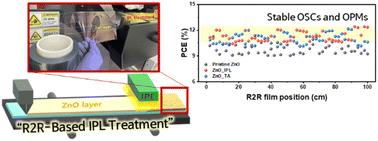Efficient roll-to-roll intense pulsed light treatment of ZnO layer for scalable flexible organic photovoltaics
IF 9.5
2区 材料科学
Q1 CHEMISTRY, PHYSICAL
引用次数: 0
Abstract
In a roll-to-roll (R2R) printing process, a high-quality coating of nanoparticle-based materials is essential to preserving the efficiency and stability of solar cells throughout the coating length. This study proposes an efficient R2R-compatible post-treatment method employing intense pulsed light (IPL) to anneal a zinc oxide (ZnO) layer in organic solar cells (OSCs) and organic photovoltaic modules (OPMs). This approach stabilizes the chemical structure and optimizes the ZnO film morphology via rapid IPL annealing to remove residual solvent and promote complete oxidation. The optimal IPL treatment condition—an energy density of 0.15 J cm−2—results in a smooth and fully oxidized ZnO film. Flexible OSCs with different coating widths of 2 and 4 cm achieve power conversion efficiencies (PCEs) of 14.24% and 13.33%, respectively, following IPL treatment. Similarly, IPL-treated flexible OPMs demonstrate a PCE of 9.27%. Compared with devices incorporating pristine ZnO layers, the IPL-treated devices exhibit enhanced efficiency and long-term stability across all sizes. These results underscore the practical viability of IPL treatment for scalable fabrication of flexible OSCs and OPMs immediately following ZnO coating. Furthermore, as coating and annealing processes are expected to be integrated within an R2R system, IPL has emerged as a promising alternative to conventional thermal annealing, effectively mitigating substrate heat damage.

用于可伸缩柔性有机光伏电池的ZnO层的高效卷对卷强脉冲光处理
在卷对卷(R2R)印刷过程中,高质量的纳米颗粒基材料涂层对于在整个涂层长度内保持太阳能电池的效率和稳定性至关重要。本研究提出了一种高效的r2r相容后处理方法,利用强脉冲光(IPL)对有机太阳能电池(OSCs)和有机光伏组件(opm)中的氧化锌(ZnO)层进行退火。该方法通过快速IPL退火去除残余溶剂,促进完全氧化,稳定了ZnO薄膜的化学结构,优化了ZnO薄膜的形貌。最佳的IPL处理条件是能量密度为0.15 J cm−2,可以得到光滑且完全氧化的ZnO薄膜。不同涂层宽度(2 cm和4 cm)的柔性OSCs经过IPL处理后,功率转换效率(pce)分别为14.24%和13.33%。同样,ipl处理的柔性opm的PCE为9.27%。与采用原始ZnO层的器件相比,ipl处理的器件在所有尺寸下都具有更高的效率和长期稳定性。这些结果强调了IPL处理在ZnO涂层后立即可扩展制造柔性osc和opm的实际可行性。此外,由于涂层和退火工艺有望集成在R2R系统中,IPL已成为传统热退火的有前途的替代方案,有效地减轻了基材的热损伤。
本文章由计算机程序翻译,如有差异,请以英文原文为准。
求助全文
约1分钟内获得全文
求助全文
来源期刊

Journal of Materials Chemistry A
CHEMISTRY, PHYSICAL-ENERGY & FUELS
CiteScore
19.50
自引率
5.00%
发文量
1892
审稿时长
1.5 months
期刊介绍:
The Journal of Materials Chemistry A, B & C covers a wide range of high-quality studies in the field of materials chemistry, with each section focusing on specific applications of the materials studied. Journal of Materials Chemistry A emphasizes applications in energy and sustainability, including topics such as artificial photosynthesis, batteries, and fuel cells. Journal of Materials Chemistry B focuses on applications in biology and medicine, while Journal of Materials Chemistry C covers applications in optical, magnetic, and electronic devices. Example topic areas within the scope of Journal of Materials Chemistry A include catalysis, green/sustainable materials, sensors, and water treatment, among others.
 求助内容:
求助内容: 应助结果提醒方式:
应助结果提醒方式:


